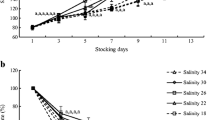Abstract
Juvenile Strongylocentrotus droebachiensis (average wet weight = 4.0 g) were held at three initial stocking densities (15, 30 and 60 animals per tray, which equates to 0.25, 0.5 and 1 kg sea urchins/m2 surface area, respectively) under constant light and temperature conditions (LD 24:0 and 8.8°C) for 380 days. The somatic growth and survival of the urchins were monitored during this period, and the gonad index (GI) was measured at the conclusion of the experiment. The sea urchins in the two lowest stocking density groups had 100% survival after 380 days in contrast to the highest stocking density group, which only had 67% survival at the conclusion of the experiment. Somatic growth was significantly higher in the lowest density group than in the medium density group, and this in turn was significantly higher than in the high-density group. The injury occurrence was highest in the high-density group (20%), lower in the medium group (7%), and there were no injuries observed (0%) in the low density groups. There were no significant differences in GI between the groups at the end of the experiment. In conclusion, the present study showed that stocking density has significant effects on somatic growth and survival of juvenile green sea urchin, S. droebachiensis and should be taken into consideration when designing sea urchin holding systems.



Similar content being viewed by others
References
Andrew NL, Agatsuma Y, Ballesteros E, Bazhin AG, Creaser EP, Barnes DKA, Botsford LW, Bradbury A, Campbell A, Dixon JD, Einarsson S, Gerring PK, Hebert K, Hunter M, Hur SB, Johnson CR, Juino-Menez MA, Kalvass P, Miller RJ, Moreno CA, Palleiro JS, Rivas D, Robinson SML, Schroeter SC, Steneck RS, Vadas RL, Woodby DA, Xiaoqi Z (2002) Status and management of world sea urchin fisheries. Oceanogr Mar Biol Annu Rev 40:343–425
Christiansen JS, Siikavuopio SI (2007) The relationship between feed intake and gonad growth of single and stocked green sea urchin (Strongylocentrotus droebachiensis) in a raceway culture. Aquaculture 262:163–167
Conand C, Sloan NA (1989) World fisheries for echinoderms. In: Caddy JF (ed) Marine invertebrate fisheries: their assessment and management. Wiley, New Jersey, pp 647–663
Hagen NT (1996) Echinoculture: from fishery to closed cycle cultivation. World Aquac December:6–19
Hagen NT, Siikavuopio SI (2007) Recent advances in sea urchin aquaculture in Norway. Bull Aquac Assoc Canada 107:16–20
James P (2007) The effects of environmental factors and husbandry techniques on roe enhancement of the New Zealand sea urchin, Evechinus choloroticus. Dr Phil. Victoria University of Wellington, 268 p
Mercier A, Hamel JF (2009) Advances in marine biology—endogenous and exogenous control of gametogenesis and spawning in Echinoderms, vol 55. Academic Press Elsevier, London
Scheibling RE, Hatcher BG (2007) The ecology of Strongylocentrotus droebachiensis. In: Lawrence JM (ed) Edible sea urchins: biology and ecology, 2nd edn. Elsevier, Amsterdam, pp 354–392
Siikavuopio SI (2009) Green sea urchin (Strongylocentrotus droebachiensis, Müller) in aquaculture: the effects of environmental factors on gonad growth, Drctor philosophiae. University of Tromsø, Norway
Siikavuopio SI, Dale T, Christiansen JS, Nevermo I (2004a) Effects of chronic nitrite exposure on gonad growth in green sea urchin Strongylocentrotus droebachiensis. Aquaculture 242:357–363
Siikavuopio SI, Dale T, Foss A, Mortensen A (2004b) Effects of chronic ammonia exposure on gonad growth and survival in green sea urchin Strongylocentrotus droebachiensis. Aquaculture 242:313–320
Siikavuopio SI, Dale T, Mortensen A (2007) The effects of stocking density on gonad growth, survival and feed intake of adult green sea urchin (Strongylocentrotus droebachiensis). Aquaculture 262:78–85
Woods CM, James P, Moss G, Wright J, Siikavuopio SI (2008) A comparison of the effect of urchin size and diet on gonad yield and quality in the sea urchin Evechinus chloroticus Valenciennes. Aquacult Int 16:49–68
Acknowledgments
The project has been financially supported by Troms Sea urchin AS. We would special like to thanks Øyvind Jørgensen and Karen Harsted at Troms Sea urchin AS for helped during this experiment. We would also like to thank staff at the Nofima, Kårvika Research Station for their technical assistance.
Author information
Authors and Affiliations
Corresponding author
Rights and permissions
About this article
Cite this article
Siikavuopio, S.I., James, P.J. Long-term effects of stocking density on somatic growth, gonad index and survival of the juvenile sea urchin, Strongylocentrotus droebachiensis . Aquacult Int 19, 741–747 (2011). https://doi.org/10.1007/s10499-010-9389-5
Received:
Accepted:
Published:
Issue Date:
DOI: https://doi.org/10.1007/s10499-010-9389-5




